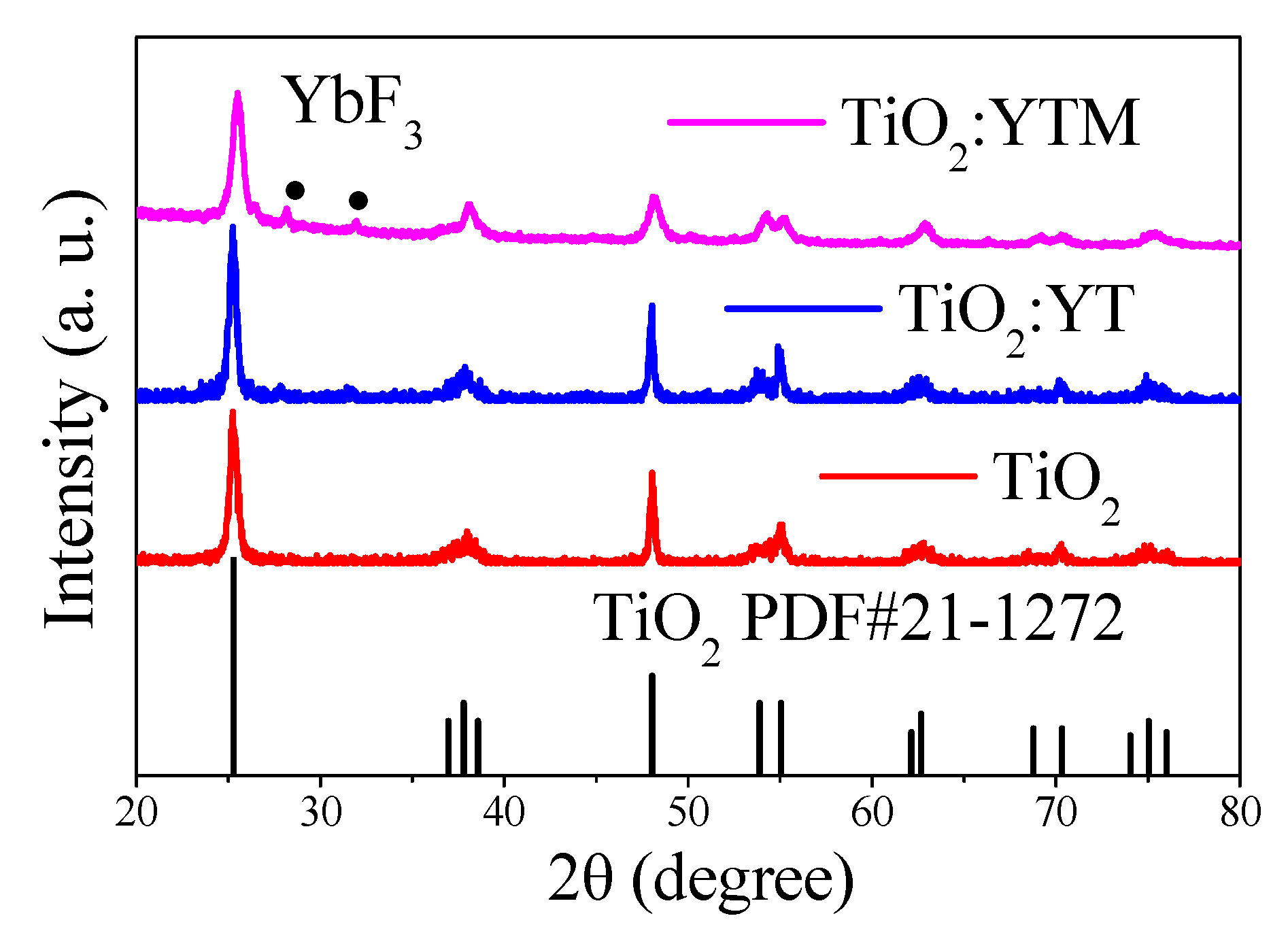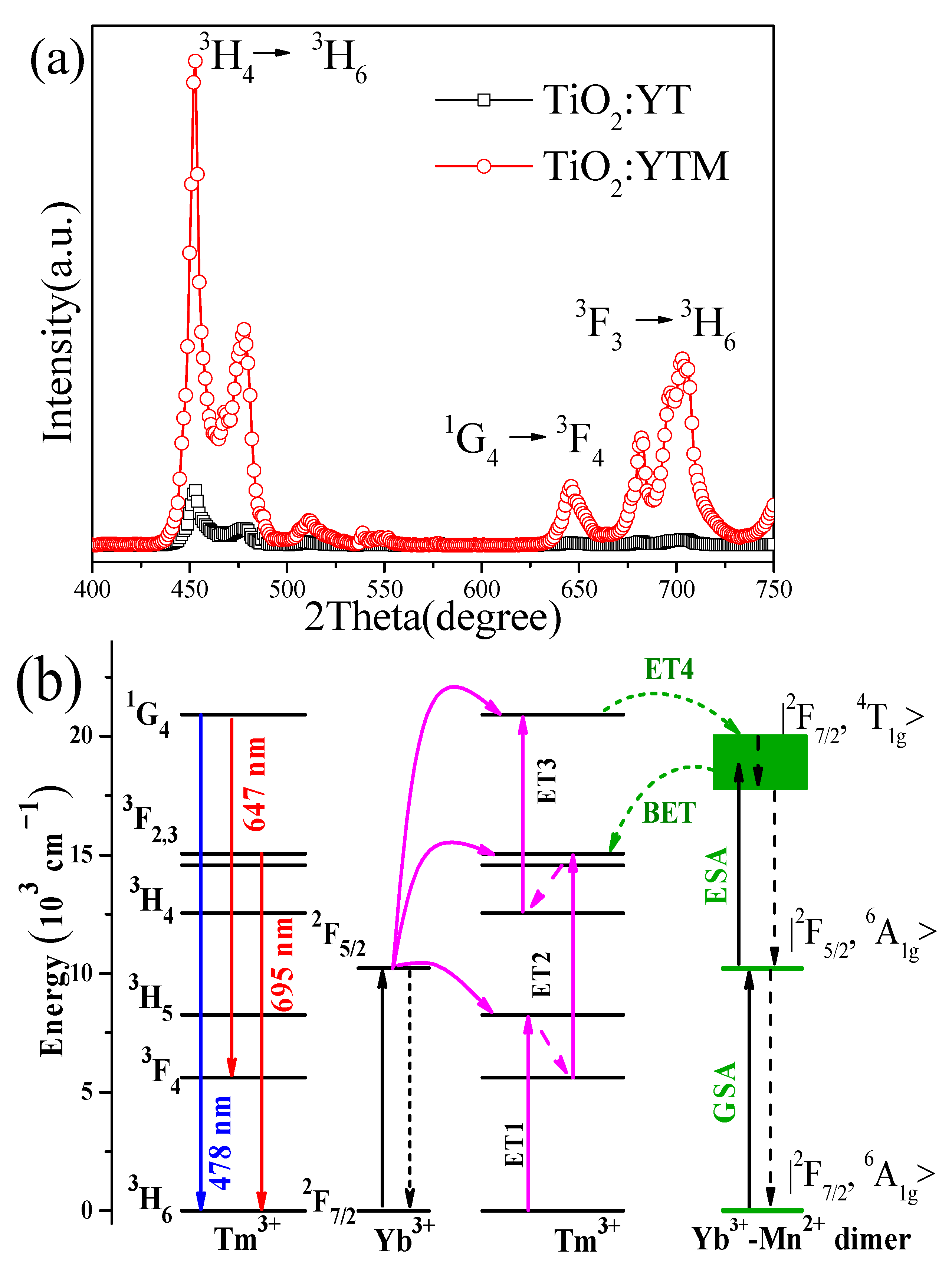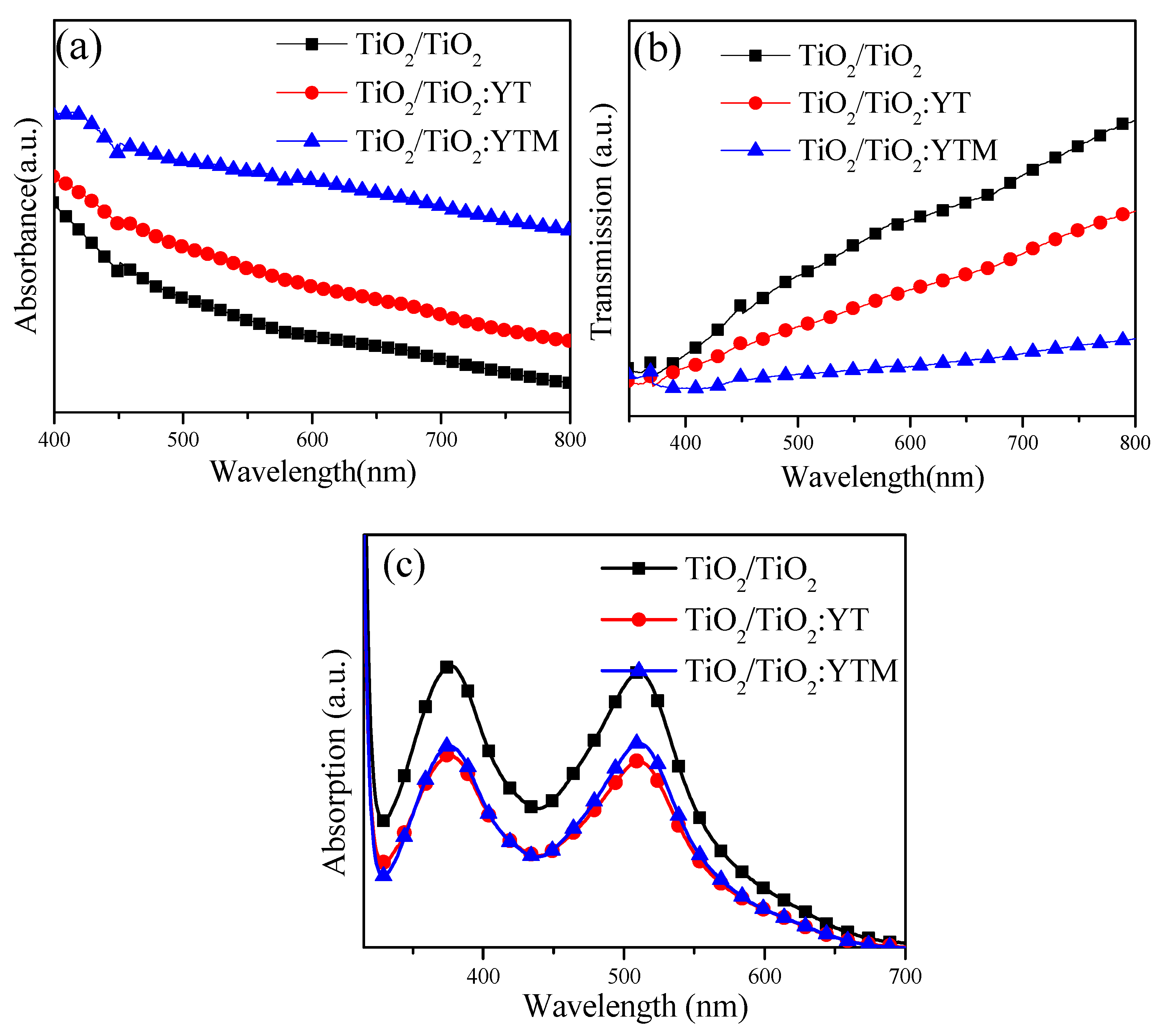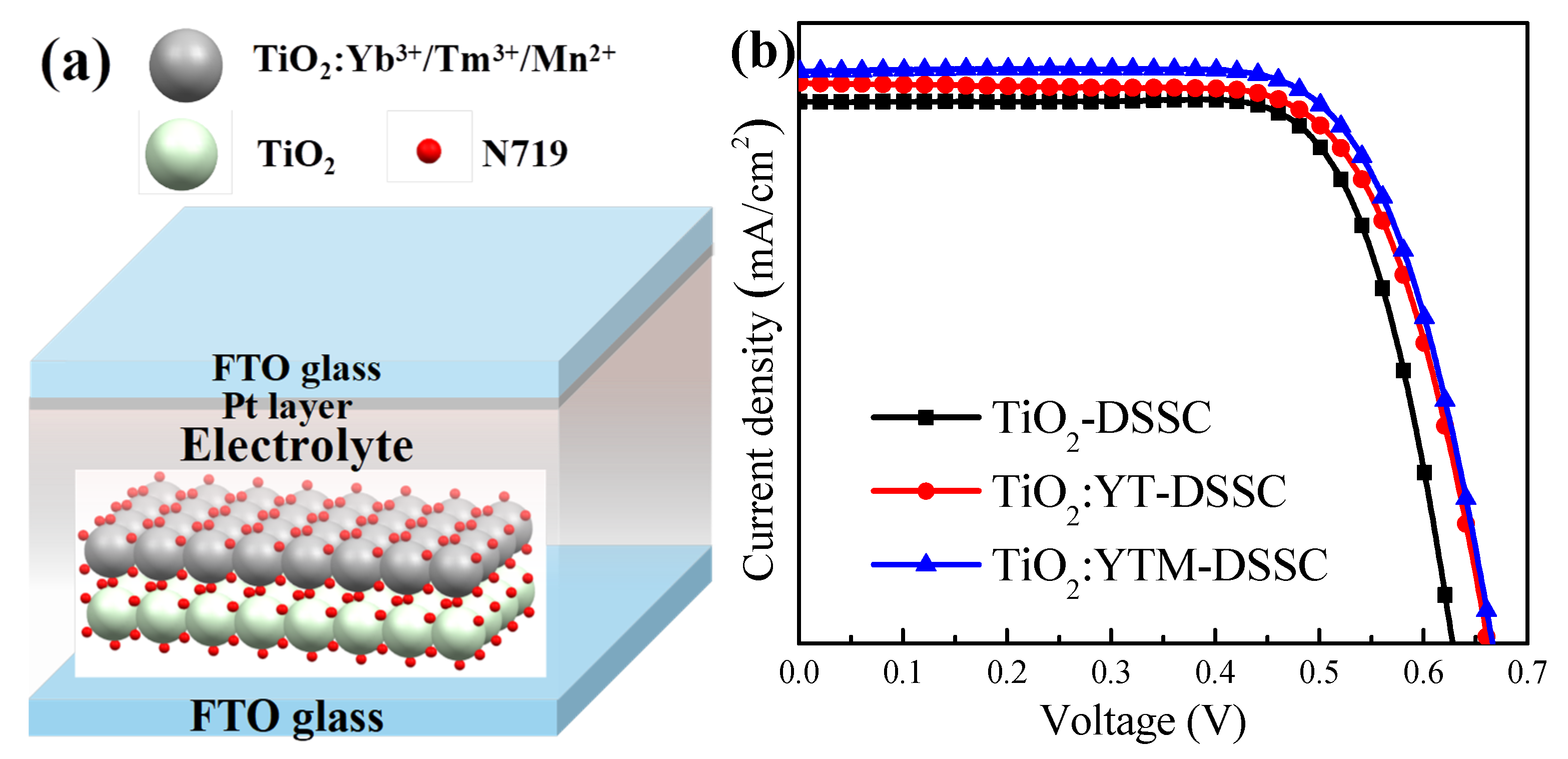Bi-Function TiO2:Yb3+/Tm3+/Mn2+-Assisted Double-Layered Photoanodes for Improving Efficiency of Dye-Sensitized Solar Cells
Abstract
:1. Introduction
2. Materials and Methods
2.1. Synthesis of TiO2 Nanosheets and TiO2:Yb3+/Tm3+/Mn2+ Nanospheres
2.2. Device Fabrication
2.3. Characterizations
3. Results
4. Conclusions
Author Contributions
Funding
Institutional Review Board Statement
Informed Consent Statement
Data Availability Statement
Conflicts of Interest
References
- Ece, M.Ş.; Ekinci, A.; Kutluay, S.; Şahin, Ö.; Horoz, S. Facile synthesis and comprehensive characterization of Ni-decorated amine groups-immobilized Fe3O4@SiO2 magnetic nanoparticles having enhanced solar cell efficiency. J. Mater. Sci. Mater. Electron. 2021, 32, 18192–18204. [Google Scholar] [CrossRef]
- Ge, Z.W.; Wang, C.L.; Chen, Z.Y.; Wang, T.; Chen, T.; Shi, R.; Yu, S.Q.; Liu, J.Q. Investigation of the TiO2 nanoparticles aggregation with high light harvesting for high-efficiency dye-sensitized solar cells. Mater. Res. Bull. 2021, 135, 111148. [Google Scholar] [CrossRef]
- Sayyed, M.I.; Askin, A.; Zaid, M.H.M.; Olukotun, S.F.; Khandaker, M.U.; Tishkevich, D.I.; Bradley, D.A. Radiation shielding and mechanical properties of Bi2O3–Na2O–TiO2–ZnO–TeO2 glass system. Radiat. Phys. Chem. 2021, 186, 109556. [Google Scholar] [CrossRef]
- Arifin, Z.; Suyitno, S.; Hadi, S.; Sutanto, B. Improved Performance of Dye-Sensitized Solar Cells with TiO2 Nanoparticles/Zn-Doped TiO2 Hollow Fiber Photoanodes. Energies 2018, 11, 2922. [Google Scholar] [CrossRef] [Green Version]
- Zatirostami, A. Increasing the efficiency of TiO2-based DSSC by means of a double layer RF-sputtered thin film blocking layer. Optik 2020, 207, 164419. [Google Scholar] [CrossRef]
- Hu, Z.; Zhao, L.; Li, W.L.; Wang, S.M.; Dong, B.H. Ag nanoparticle-modified double-layer composite film based on P25/NaLuF4:Yb3+/Er3+ and flower TiO2 for highly efficient dye-sensitized solar cells. Appl. Sur. Sci. 2019, 491, 286–293. [Google Scholar] [CrossRef]
- Ambapuram, M.; Maddala, G.; Simhachalam, N.B.; Sripada, S.; Kalvapalli, S.; Pedda, V.S.Y.; Mittya, R. Highly effective SnS composite counter electrode sandwiched bi-function CeO2:Er3+/Yb3+ assisted surface modified photoelectroded dye sensitized solar cell exceeds 9.5% efficiency. Sol. Energy 2020, 207, 1158–1164. [Google Scholar] [CrossRef]
- Luo, X.T.; Cha, J.G.; Fu, G.M.; Lee, H.W.; Kim, S.H. Enhanced light harvesting in dye-sensitized solar cells enabled by TiO2:Er3+, Yb3+ upconversion phosphor particles as solar spectral converter and light scattering medium. Int. J. Energy Res. 2021, 45, 16339–16348. [Google Scholar] [CrossRef]
- Bai, J.Y.; Duan, P.P.; Wang, X.; Han, G.; Wang, M.; Diao, G.W. Upconversion luminescence enhancement by Fe3+ doping in CeO2:Yb/Er nanomaterials and their application in dye-sensitized solar cells. RSC Adv. 2020, 10, 18868–18874. [Google Scholar] [CrossRef]
- Qin, R.P.; Jinhua, X.W.; Hu, J.H.; Zhao, L. Effect of luminescent material NaYbF4:Ho3+ on the photovoltaic performance of dye-sensitized solar cells. J. Mater. Sci. Mater. Electron. 2021, 32, 1445–1456. [Google Scholar] [CrossRef]
- Fu, H.H.; Liu, Y.S.; Jiang, F.L.; Hong, M.C. Controlled synthesis and optical properties of lanthanide-doped Na3ZrF7 nanocrystals. Chin. J. Struct. Chem. 2018, 37, 1737–1748. [Google Scholar]
- Wang, Z.; Liu, C.H.; Chang, L.J.; Li, Z.P. One-pot synthesis of water-soluble and carboxyl-functionalized β-NaYF4:Yb,Er(Tm) upconversion nanocrystals and their application for bioimaging. J. Mater. Chem. 2012, 22, 12186–12192. [Google Scholar] [CrossRef]
- Zhang, M.; Zuo, M.M.; Wang, C.X.; Li, Z.; Cheng, Q.Y.; Huang, J.; Wang, Z.J.; Liu, Z.H. Monitoring Neuroinflammation with an HOCl-Activatable and Blood-Brain Barrier Permeable Upconversion Nanoprobe. Anal. Chem. 2020, 92, 5569–5576. [Google Scholar] [CrossRef] [PubMed]
- Qian, Y.N.; Tang, X.Z.; Zhang, Z.Y.; Zhang, H.Y.; Ivanov, M.; Wu, Q.B. Multicolor-tunable upconversion emission of lanthanide doped 12CaO∙7Al2O3 polycrystals. Mater. Lett. 2018, 220, 269–271. [Google Scholar] [CrossRef]
- Chai, Z.Z.; Yang, Z.W.; Qiu, J.B.; Zhu, J.L.; Song, Z.G. Embedding Ag or Au nanoparticles within the nano-sized wall of YbPO4:Er3+ inverse opals and resulting enhanced upconversion luminescence. Ceram. Int. 2018, 44, 13757–13764. [Google Scholar] [CrossRef]
- Tsebriienko, T.; Popov, A.I. Effect of Poly(Titanium Oxide) on the Viscoelastic and Thermophysical Properties of Interpenetrating Polymer Networks. Crystals 2021, 11, 794. [Google Scholar] [CrossRef]
- Jarosz-Duda, A.; O’Callaghan, P.; Kuncewicz, J.; Łabuz, P.; Macyk, W. Enhanced UV Light Emission by Core-Shell Upconverting Particles Powering up TiO2 Photocatalysis in Near-Infrared Light. Catalysts 2020, 10, 232. [Google Scholar] [CrossRef] [Green Version]
- Du, X.; He, J.H.; Zhao, Y.Q. Facile Preparation of F and N Codoped Pinecone-Like Titania Hollow Microparticles with Visible Light Photocatalytic Activity. J. Phys. Chem. C 2009, 113, 14151–14158. [Google Scholar] [CrossRef]
- Zhang, Q.J.; Fu, Y.; Wu, Y.F.; Zuo, T. Lanthanum-Doped TiO2 Nanosheet Film with Highly Reactive {001} Facets and Its Enhanced Photocatalytic Activity. Eur. J. Inorg. Chem. 2016, 2016, 1706–1711. [Google Scholar] [CrossRef]
- Zhou, J.K.; Lv, L.; Yu, J.Q.; Li, H.L.; Guo, P.Z.; Sun, H.; Zhao, X.S. Synthesis of Self-Organized Polycrystalline F-doped TiO2 Hollow Microspheres and Their Photocatalytic Activity under Visible Light. J. Phys. Chem. C 2008, 112, 5316–5321. [Google Scholar] [CrossRef]
- Qu, P.; Wang, K.F.; Li, J.; Wang, S.Z.; Wei, W. Upconverting TiO2 spheres with light scattering effect for enhanced quantum dot-sensitized solar cells. Mater. Express 2020, 10, 556–562. [Google Scholar] [CrossRef]
- Ji, H.M.; Xu, M.G.; Zhang, H.Y.; Li, X.L.; Qian, Y.N. Enhanced Upconversion Emissions of TiO2:Yb3+/Tm3+ Nanocrystals: Comparison with Different Effects of Li+, Mn2+ and Cu2+ Ions. Chin. J. Struct. Chem. 2021, 40, 1379–1384. [Google Scholar]
- Tishkevich, D.; Grabchikov, S.; Zubar, T.; Vasin, D.; Trukhanov, S.; Vorobjova, A.; Yakimchuk, D.; Kozlovskiy, A.; Zdorovets, M.; Giniyatova, S.; et al. Early Stage Growth Mechanism and Synthesis Conditions Dependent Morphology of Nanocrystalline Bi Films Electrodeposited from Perchlorate Electrolyte. Nanomaterials 2020, 10, 1245. [Google Scholar] [CrossRef] [PubMed]
- Casagrande, E.; Back, M.; Cristofori, D.; Ueda, J.; Tanabe, S.; Palazzolo, S.; Rizzolio, F.; Canzonieri, V.; Trave, E.; Riello, P. Upconversion-mediated Boltzmann thermometry in double-layered Bi2SiO5:Yb3+,Tm3+@SiO2 hollow nanoparticles. J. Mater. Chem. C 2020, 8, 7828–7836. [Google Scholar] [CrossRef]
- Li, G.W.; Liu, Y.S.; Jiang, F.L.; Hong, M.C. Ultrasmall lanthanide-doped NaMgF3 nanocrystals: Controlled synthesis and optical properties. Chin. J. Struct. Chem. 2020, 39, 2001–2008. [Google Scholar]
- Ji, H.M.; Tang, X.Z.; Zhang, H.Y.; Li, X.L.; Qian, Y.N. Optical Temperature Sensing of YbNbO4:Er3+ Phosphors Synthesized by Hydrothermal Method. Coatings 2021, 11, 383. [Google Scholar] [CrossRef]
- Hao, S.W.; Shang, Y.F.; Hou, Y.D.; Chen, T.; Lv, W.Q.; Hu, P.G.; Yang, C.H. Enhance the performance of dye-sensitized solar cells by constructing upconversion-core/semiconductor-shell structured NaYF4:Yb,Er@BiOCl microprisms. Sol. Energy 2021, 224, 563–568. [Google Scholar] [CrossRef]






| Double-Layered Photoanodes | Voc (V) | Jsc (mA/cm2) | FF | PCE (%) | Ref. |
|---|---|---|---|---|---|
| TiO2-DSSC | 0.63 | 14.84 | 0.73 | 6.84 | This work |
| TiO2:YT-DSSC | 0.66 | 15.37 | 0.70 | 7.12 | This work |
| TiO2:YTM-DSSC | 0.67 | 15.68 | 0.71 | 7.41 | This work |
| ZnO/TiO2/TiO2 | 0.727 | 16.63 | 0.59 | 6.84 | [5] |
| NaLuF4:Yb/Er/P25/flower-like TiO2/Ag | 0.69 | 21.19 | 0.56 | 8.14 | [6] |
| CeO2:Fe/Yb/Er/TiO2 | 0.744 | 16.704 | 0.61 | 7.30 | [9] |
| YbF4:Ho/TiO2 | 0.693 | 15.62 | 0.696 | 7.52 | [10] |
| NaYF4:Yb, Er@BiOCl/TiO2 | 0.74 | 13.06 | 0.7119 | 6.88 | [27] |
| TiO2:Er3+, Yb3+/TiO2 | 0.68 | 15.30 | 0.68 | 7.18 | [8] |
Publisher’s Note: MDPI stays neutral with regard to jurisdictional claims in published maps and institutional affiliations. |
© 2022 by the authors. Licensee MDPI, Basel, Switzerland. This article is an open access article distributed under the terms and conditions of the Creative Commons Attribution (CC BY) license (https://creativecommons.org/licenses/by/4.0/).
Share and Cite
Chen, D.; Fu, X.; Li, X.; Qian, Y. Bi-Function TiO2:Yb3+/Tm3+/Mn2+-Assisted Double-Layered Photoanodes for Improving Efficiency of Dye-Sensitized Solar Cells. Coatings 2022, 12, 744. https://doi.org/10.3390/coatings12060744
Chen D, Fu X, Li X, Qian Y. Bi-Function TiO2:Yb3+/Tm3+/Mn2+-Assisted Double-Layered Photoanodes for Improving Efficiency of Dye-Sensitized Solar Cells. Coatings. 2022; 12(6):744. https://doi.org/10.3390/coatings12060744
Chicago/Turabian StyleChen, Di, Xiang Fu, Xiaolong Li, and Yannan Qian. 2022. "Bi-Function TiO2:Yb3+/Tm3+/Mn2+-Assisted Double-Layered Photoanodes for Improving Efficiency of Dye-Sensitized Solar Cells" Coatings 12, no. 6: 744. https://doi.org/10.3390/coatings12060744
APA StyleChen, D., Fu, X., Li, X., & Qian, Y. (2022). Bi-Function TiO2:Yb3+/Tm3+/Mn2+-Assisted Double-Layered Photoanodes for Improving Efficiency of Dye-Sensitized Solar Cells. Coatings, 12(6), 744. https://doi.org/10.3390/coatings12060744





